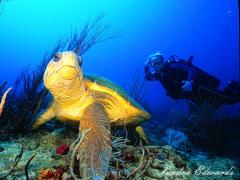Loggerhead (Caretta caretta)
|
|
This photograph is used with the kind permission of Sandra Edwards. More of her turtle photographs can be found in "Turtles of Palm Beach", a photo essay she prepared for the August '95 issue of the South Florida Dive Journal.
77K JPEG
|
The following is based on information from the Recovery Plan for U.S. Population of Loggerhead Turtles, U.S Fish and Wildlife Service and National Marine Fisheries Service, 1993. Obtained from the U.S. National Marine Fisheries Service, and used with their kind permission.
Current Status
The loggerhead was listed in 1978 as a threatened species and it is considered "vulnerable" by the International Union for the Conservation of Nature. Recent population studies have concluded that the number of females that nest in the Southeast U.S. is continuing to decline.
The U.S. Federal government has listed the loggerhead as endangered worldwide. In the U.S., the loggerhead's nesting areas are divided among four states:
- Florida (91%)
- South Carolina (6.5%)
- Georgia (1.5%)
- North Carolina (1%)
Florida beaches account for one third of the world's total population of loggerheads.
Description
The carapace of subadult/adult loggerheads is reddish-brown. The plastron is medium-yellow. Average carapace length is about 92 cm and average body mass about 113 kg.
Hatchlings can vary in colour from light to dark brown. Flippers are dark brown with white margins. The plastron and other underparts have a faded yellow ochre appearance.
While the Recovery Plan (being a scientific document) makes no mention of this, Turtle Trax would be remiss not to mention it here. Hatchling loggerheads (like all young sea turtles) are cute and engaging animals.
Extensive ground and aerial surveys as recently as 1990 put loggerhead nest estimates at 50,000-70,000 per year in the Southeast U.S. This number represents approximately 35-40% of the world population of loggerhead turtles.
Habitat
It is assumed that hatchlings live out their "lost years" in rafts of sargassum and/or debris in open ocean drift lines. They remain part of this drifting community and grow to 40 or 50 cm carapace length. They then migrate to the shallower coastal waters which become their foraging habitat.
It is interesting that some loggerheads live in turbid, detritus-laden, muddy bottom bays and bayous of the northern Gulf Coast, while others choose to live in the clear waters of the Bahamas and Antilles, in habitats we more closely associate with tropical marine turtles. Nothing is known about why these creatures would select such vastly different habitats, or even if there is any movement from one to the other.
Diet
Subadult and adult loggerheads primarily feed upon bottom dwelling invertebrates. Loggerheads sometimes scavenge fish or fish parts, but they are not considered fish eaters.
Reproduction
The loggerhead mating season is from late March to early June. Little is known about courtship or mating habits of the loggerhead (or those of any other sea turtle, for that matter). This area is not well studied and needs further research so that we can better understand reproductive behaviours.
In the southeastern United States, adult females begin to nest as early as late April and they continue right up to early September. Nesting activity is at its peak in June and July. Average clutch size varies from 100 to 126 eggs along the southeastern United States coast.
Loggerheads nest at night. The average interval between nesting seasons is two to three years, but this can vary from one to six years. Natural incubation periods range from 53-55 days in Florida to 63-68 days in Georgia. The time it takes for eggs to hatch is inversely related to temperature. As with all sea turtles, sex determination in hatchlings is also temperature dependent.
Threats
The loggerhead shares the same threats that menace all marine turtles, as described in Threats To Marine Turtles. Because such a significant percentage of the world's loggerhead population lives in Gulf and southwest Atlantic waters, shrimp fishing, gill netting, and activities associated with offshore oil and gas exploitation are particulary dangerous to this species.
Loggerhead Quick Facts
Reprinted from Florida's Sea Turtles, Copyright 1992, courtesy the Florida
Power & Light Company.
The loggerhead is the most common sea turtle in Florida.
- Named for its large head
- Powerful jaws crush mollusks, crabs and encrusting animals attached to reefs and rocks
- An estimated 14,000 females nest in the southeastern U.S, each year
- A large turtle: adults weigh 200 to 350 pounds and measure about 3 feet in length
- Hatchlings: 2 inches long
- Nest in Florida from late April to September
- Survival in Florida threatened by drowning in shrimp trawls and habitat loss
Last modified 04/01/24
Send comments or corrections to webmaster@turtles.org
